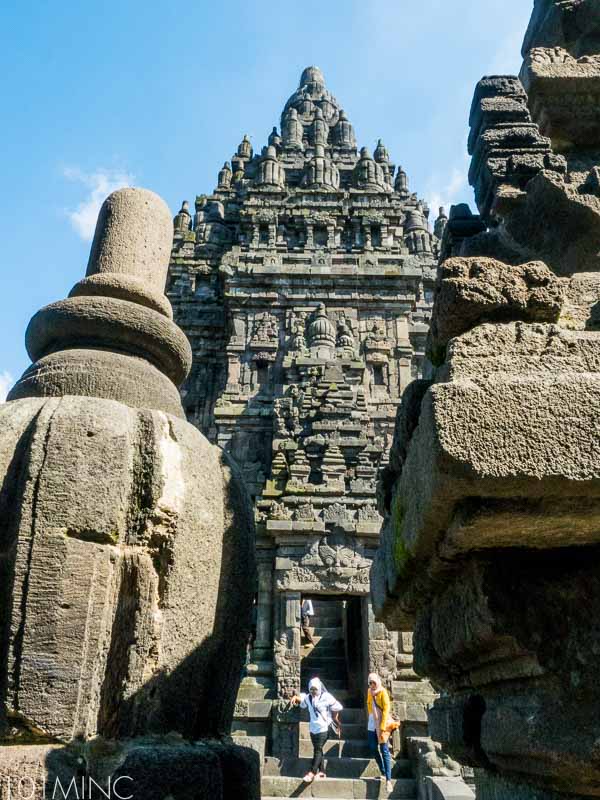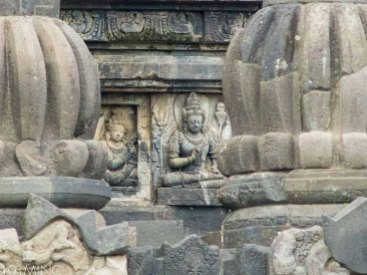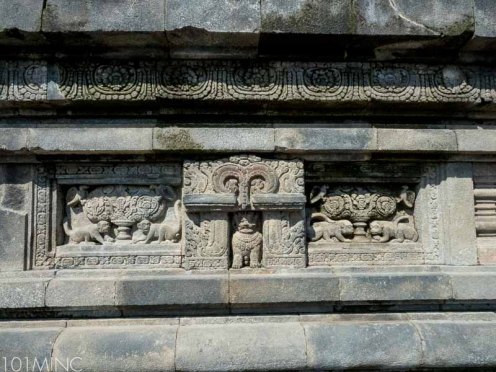Our first stop is Prambanan, a group of Hindu temples built by one of the firsts national united kingdoms in Indonesia.

For our second day, we chartered a Gojek (car) driver to take us for a whole day to several temples. 12 hours for Rp.600.000 (around USD$41.83) for 1 car Toyota Avanza AC + 1 driver + gasoline and his lunch included.
We decide to buy the entrance ticket to Prambanan and Ratu Boko. Both tickets cost us around Rp. 75.000 (around USD$5.23) for local tourist. For foreigners, they need to pay around USD$25 only for Prambanan. Ticket can combine with Borobudur or Ratu Boko but will cost extra $.


One can explore the Prambanan from one end to another by walking but they also provide shuttle bus to other temples farther.


Prambanan construction started during Sanyaja Dynasty by Rakai Pikatan in 856 CE to compete with the Sailendra Dynasty’s Sewu complex nearby, and the famous Borobudur temple. It is also a transition in the Medang or the Mataram court shifting from Mahayana Buddhism to Shaivite Hinduism. Hence, the compound was expanded by King Lokapala and Balitung Maha Sambu the Sanjaya king and the Mataram Sultanate.
After the Kingdom declined, Prambanan was abandoned and fall into ruin by an earthquake in the 16th century. In 1811, Colin Mackenzie, an officer under Sir Thomas Stamford Raffles of the Brittish army, found the temple. Many of the statues and materials were stolen since then. In 1930 finally, restoration properly began. The major restoration completed by 1953 and inaugurated by Ir. Sukarno, Indonesia first president. At least the main temples are built but many of the smaller shrines are left like a pile of stacked stones. In 1990’s the Government establish the surrounding area into an archeology park and some renovation and preservation still going on until now.




Source: Wikipedia
Prambanan is considered one of the biggest Hindu temple in Indonesia and Southeast Asia. The principle of building the complex is in accordance to Hindu architecture in Wastu book of literature. It’s inspired by the Mahameru mountain, dwelling of the Hindu Gods and model after a mandala, the universe in Hindu cosmology.
Prambanan 3 main candi (temples) are dedicated to the Trimurti (Brahma the Creator, Vishnu the Preserver and the largest, Shiva the Destroyer). The largest building is dedicated to Lord Shiva with the height of 47 meters. Hence, previously Prambanan was named Shiva-grha (the House of Shiva) or Shiva-laya (the Realm of Shiva).
Another 3 smaller wahana, temples dedicated to each vehicle for the Trimurti gods; Nandi (vehicle for Shiva), Garuda (vehicle for Vishnu), and Hamsa (vehicle for Brahma). There are also 224 perwara (shrines) in various state of repair. Prambanan is an UNESCO World Heritage Site since 1991.



Candi (Temple) of Shiva
Shiva temple has 4 chambers with the main chamber of course dedicated to Shiva Mahadeva, a 3 meters statue of the God who wore skull and sickle with third eye on the forehead. The four hands hold prayer beads, feather duster, and trident. It stands on a lotus pad and yoni pedestal with naga serpents adorning the base.



There are 3 other chambers with Hindu Gods with a close connection to Shiva.

Chamber of Agastya, facing south. He is Shiva’s teacher and his story was in Javanese text Agastya-parva.
Chamber of Ganesha, facing west. Ganesha is Shiva’s and Parvati’s son.

Unfortunately, I didn’t get to take the photo of Durga Mahisasuramardini, wife of Shiva, the inspiration of Roro Jonggrang. Credit: Wikipedia.
Prambanan is also called Loro Jonggrang. Since the decline of Hinduism, Prambanan is abandoned but the Javanese people around it get inspiration and create folklore about a cursed princess named Loro Jonggrang from the statue of Durga Mahisasuramardini in the Shiva temple.
Legend has it that princess Loro Jonggrang from the Boko Kingdom is the most beautiful princess of the land. Her father, Prabu Boko, wanted to conquer the neighboring kingdom, Pengging, but he was defeated and killed by Pegging’s crown prince, Bandung Bondowoso. The Prince falls in love with the Princess and wants to marry her.
To refuse him, Loro Jonggrang challenged the Prince for an impossible task, to build her 1000 temples in 1 night. However, Bandung Bondowoso is not an ordinary prince. He uses his supernatural power and summons earth jinn or spirits to help him. 999 temples are completed near dawn. The Princess and her ladies-in-waiting make a loud noise and woke up the rooster to crow, signaling dawn has come. The jinn fled before the 1000th temple is finished. Angry for the deception, the Prince curses the Princess and she turned to stone, the Durga Mahisasuramardini in Shiva temple.

Some of the steps are pretty high and dangerous so be very careful going up and down from one temple to another.

Candi (Temple) of Brahma on the south.

Inside there’s 20 meters wide and 33 meters high of Brahma statue.

Candi (Temple) of Vishnu on the north.

Inside there’s 20 meters wide and 33 meters high of Vishnu statue.
What interests me the most is the detail of each stone carving on the temples.

Lion with Kalpataru (Divine tree or world tree that said can grant a wish) trees and each with a pair of kinnaras (half woman-half bird creature, celestial performers) and some temples have other animals like monkeys.

Jalawadra. Water drainage in the shape of a dragon or other mythical creature.
The carving relief in Temple of Shiva and Temple Brahma depicted the story from Ramayana epic saga like the scenes when Princess Sita is abducted by Ravana, a Rakshasa king. With the help of Hanuman (the monkey king), Prince Rama (Sita’s husband) is able to rescue her and defeat Ravana.
On Vishnu temple, the carvings depicted the epic saga from Krishnayana. As Krishna is one of Vishnu avatar, the story revolves around Krishna life and his tribulation.
Originally we wanted to watch the Ramayana performance that also a highlight in Prambanan, but at the time they don’t have the outdoor performance with the Prambanan backdrop. Maybe next time.



Mahakala in some of the doors and gates. He’s is one of the deities of destruction.

A ratna or the jewel from the north apit temple’s top that fell from the earthquake in 2006 is left here is a monument to remember it.
After a long morning, we decide to take a rest in a nearby cafe and buy a glass of jamu (herbal medicine) to keep up our strength and a bottle of cold water.
Next: Lunch then to Candi (temple) Ijo
Yogyakarta Travel:
- [Travel] Yogyakarta | On Arrival
- [Travel] Yogyakarta | Kraton Yogyakarta, Designed by Javanese Culture and Believes
- [Travel] Yogyakarta | the House of Raminten, Peculiar and Eclectic Style.
- [Travel] Yogyakarta | Prambanan, The Legend of the Cursed Princess and the Gods
- [Travel] Yogyakarta | Candi Ijo, City Overview from the Highest Temple in Yogyakarta
- [Travel] Yogyakarta | The Beauty Queen, Ratu Boko
- [Travel] Yogyakarta | Heavenly Sunrise from Punthuk Setumbu
- [Travel] Yogyakarta | Borobudur, Largest 3D Narrative of Buddha’s Journey to Enlightenment
- [Travel] Yogyakarta |Taman Sari, Leasure complex for the Sultan and His Concubines
- [Travel] Yogyakarta | The Two-Face of Jogjakarta Art – Tradition Meet Modern Art
- [Travel] Yogyakarta | Affandi, The Expressionist Painter and the Earliest Advertiser in Indonesia
- [Travel] Yogyakarta | Good Morning Pasar Legi Kotagede
- [Travel] Yogyakarta | The Last Resting Place for The Mataram Sultans at Kotagede
- [Travel] Yogyakarta | The Remnants of the Mataram Sultanate at Kota Gede
Source: UNESCO, Taman Wisata Candi Yogyakarta, Wikipedia, Lonely Planet



































11 Comments Add yours